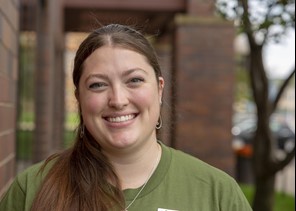What is the MN GreenStep cities program and how does Duluth benefit?
by Annika Frazer, UMD Sustainability Communications Intern, July 2020

Duluth, MN is inherently an environmental and outdoor city with extensive parks and greenspace, with scenic views of the St. Louis River and Lake Superior along nearly the entire 27-mile length of the city. City staff are busy working to improve operations and be more sustainable, but tracking and documenting these changes can be a challenge. That’s where Kaija Roy, a Minnesota GreenCorps member who served with the City from September 2019 to September 2020 has shined!
Kaija dug into the data and worked on fixing the city’s utility tracking, conducted a plug load inventory of over 1,500 devices at City Hall, and researched improvements for the City’s e-bike program. She particularly enjoyed meeting and working with many different people across the city, learning about their projects, and finding ways to track them. In addition to tracking and managing energy use for the city, Kaija was able to gather information for Duluth to achieve Step #4 of the Minnesota GreenStep cities program. GreenSteps is a state based, 5 step program described as a “voluntary challenge, assistance, and recognition program to help cities achieve their sustainability and quality of life goals. Voluntary actions are tailored to all Minnesota cities, focus on cost savings and energy use reduction, and encourage civic innovation.”
Duluth joined GreenSteps cities in 2014 by building community interest, having program staff visit the city, and adopting a city resolution. The city reached Step #2 in 2015 by implementing 8 best practices from the GreenStep program. Duluth stayed at Step #2 for four years, until September of 2019 when Kaija joined the city staff. She facilitated the implementation of an additional 8 best practices, bringing the city to Step #3. Kaija explained that since Duluth has a naturally sustainability-based structure, much of the information was already available, but it was hidden within pages and pages of data! Kaija filed through 175 actions of the GreenSteps program in accordance with various city zoning codes, data sheets, and worked with other staff members to measure and report city performance metrics. Her work brought the city at Step #4 of the program. Duluth now has the fundamental data organization and infrastructure to be able to track improvement in various areas across the city and its departments. Kaija is happy to say that Duluth can stay at this step and choose to grow to Step #5 if we continue to show improvement in our city performance metrics every year, now that she has built the framework for improvement.
One of the benefits of the GreenSteps program is that it makes the hidden efforts within City operations more visible. The organization of massive amounts of energy data is reason enough to applaud Kaija Roy and her work in facilitating such progress within the GreenStep program. Kaija explained the recognition of being within the top 14% of MN GreenStep cities and how the program can expand into a resource used by people and businesses looking to move or venture into environmentally conscious efforts.
Kaija Roy has finished her service after one year in MN GreenCorps, and is moving on to a Building Science position with a Minnesota company. However, her skills in data management and ability to work across departmental boundaries with dedicated, passionate, and diverse staff members will stay with her. Kaija stated her new motto is “if you don’t track it, you don’t know it” and explained her newfound passion for energy management and helped to facilitate informed decisions about sustainability. Our city has worked to protect and enhance our natural resources out of habit, but Kaija identified areas of growth that could be achieved as the city becomes more intentional when updating its data management systems and making infrastructure decisions. Thanks to Kaija, Duluth is on the way to being a top MN GreenStep city, with reduced energy costs and the ability to become an example for the rest of the state, all of which creates ongoing motivation for our progress to continue.




